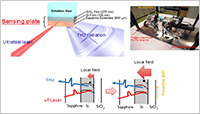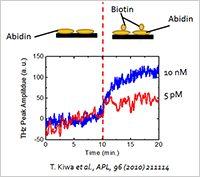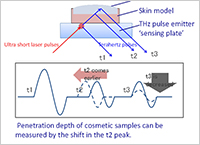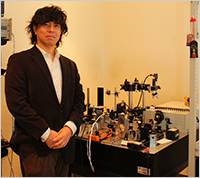Enlarge Image Recent results
Label free immunoassay
Novel label-free, none-destructive THz-time-of-flight evaluation of cosmetic penetration into artificial human skins
Enlarge Image T. Arisawa, JSAP-OSA joint symposia 13-16, Sep. 2015, Nagoya, Japan.
Enlarge Image Imaging catalytic reactions at the electrodes of fuel cells
T. Kiwa, et al. Optics Express 20, 11637-11642 (2012).
Enlarge Image Toshihiko Kiwa, Associate Professor, Graduate School of Natural Science and Technology, Okayama University.
Enlarge Image
Terahertz chemical microscope: Innovative terahertz technology for high resolution mapping of chemical reactions, label free immunoassays, cosmetics research, and more.
Toshihiko Kiwa, Associate Professor, Graduate School of Natural Science and Technology, Okayama University.
“My first encounter with terahertz physics and technology was during my master’s degree,” says Toshihiko Kiwa, an associate professor at the Graduate School of Natural Science and Technology, Okayama University. “Then, my research moved to superconductor photonics and 800 GHz high frequency Josephson junction devices. My desire to find innovative applications for terahertz technology led to the invention of the Terahertz Chemical Microscope (TCM).”
Terahertz (THz) radiation refers to electromagnetic spectrum in the range 0.3 to 30 terahertz, where 1 THz = 1 x 10 12 Hz, and corresponds to wavelengths of approximately 1 mm to 0.01 mm. So the terahertz range fits into the gap between microwave and infrared radiation. Terahertz radiation penetrates plastics, concrete, and clothing thereby finding applications that include non-destructive quality control of electronic components and manufacturing processes, security surveillance, and imaging of human tissue. Terahertz radiation also has fundamental scientific applications such as spectral analysis of galaxies and materials research.
“Although so called terahertz time-domain spectroscopy (TDS) is used for nondestructive testing, terahertz radiation does not penetrate water, explains Kiwa. “So it is very challenging to use terahertz radiation to determine the physical properties of chemical and aqueous solutions.” Kiwa and colleagues overcame the limitation of conventional terahertz spectroscopy by inventing the TCM for mapping electric potentials of chemical reactions in aqueous solutions. The fundamental distinguishing feature of the TCM is that the imaging process entails irradiating pulsed light from a femtosecond laser onto a specially designed sensing plate and detecting the resulting emission of terahertz from the sample. So the spatial resolution of the images is only limited by the incident light (typically ~800 nm) and not by the wavelength of the actual terahertz radiation that is generated in the sample, which is typically 300 micrometers.
Operating principle of the terahertz chemical microscope
The sensing plate is one of the key components of the TCM. In its simplest form, it consists of thin films of silicon oxide and silicon deposited on a sapphire substrate. Now, pulsed light from a femtosecond laser incident on the sensing results in the generation of terahertz radiation that is captured by a photoconducting detector. Importantly, chemical reactions at the surface of the sensor induce fluctuations in the magnitude of the local electric potential that in turn result in corresponding changes in the intensity of the terahertz radiation emanating from the sensor. The changes in the magnitude of the terahertz radiation are a signature of the chemical composition of the aqueous solution on the sensor.
“We the terahertz radiation is generated at exactly the same location as the incident light,” says Kiwa. “So by scanning the femtosecond laser we can produce image of the chemical nature of the surface of the sensor.” Kiwa and colleagues are extending the applications of the TCM to areas including label free immunoassays, monitoring catalytic reactions in fuel cells, and determining the depth of penetration of cosmetics into the human skin.
Further information
▼Reference(e-Bulletin) :
High-performance Terahertz Project kick-off symposium. Vol.11, June, 2015.
http://www.okayama-u.ac.jp/user/kouhou/ebulletin/news/vol11/news_003.html
Simple, compact, highly sensitive SQUID based magnetic field measurement
sysytem to detection of a very small magnetic signals. Vol.10, February,2015.
http://www.okayama-u.ac.jp/user/kouhou/ebulletin/research_highlights/vol10/highlights_004.html
Unique terahertz chemical microscope for mapping chemical reactions.
Vol.4, September, 2013.
http://www.okayama-u.ac.jp/user/kouhou/ebulletin/ipe/vol4/ipe_001.html
▼Toshihiko Kiwa group website
http://www.sense.ec.okayama-u.ac.jp/member.html





